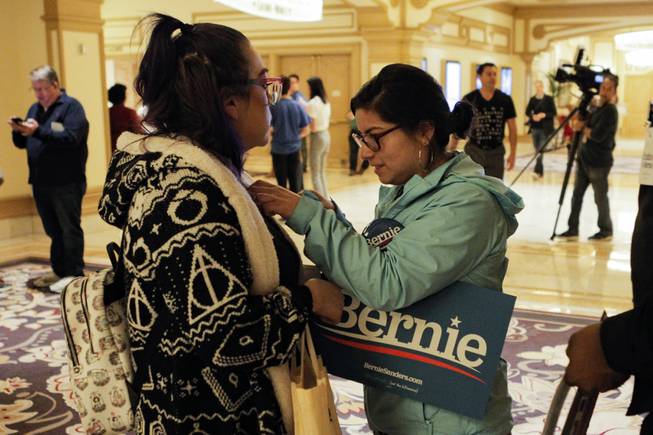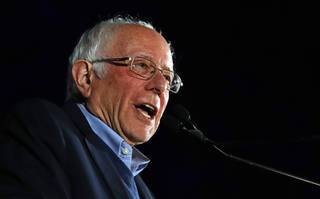
Anahi Tapia Torres (right), a campaign staffer for Sen. Bernie Sanders, helps volunteer Rosanna Gonzales put on a campaign pin during the Nevada 2020 Caucus at Bellagio in Las Vegas, NV Saturday, Feb. 22, 2020.
Sunday, Feb. 23, 2020 | 2 a.m.
Four years ago, Bernie Sanders’ struggles to win over minority voters played a key role in his loss to Hillary Clinton for the Democratic presidential nomination.
Saturday in Nevada, the Vermont senator served notice that this time around would be different.
In the first state in the electoral process to feature large Latino and African American communities, early results of the Nevada caucuses indicated a runaway victory for Sanders. Demographic breakdowns of the results weren’t immediately available, but his support among minority voters was reflected in the strength of Sanders’ performance —he had 46.3% of the vote with about a quarter of precincts reporting — along with information from entrance and exit polling.
“In Nevada, we have just put together a multigenerational, multiracial coalition that is not only going to win Nevada, it’s going to sweep this country,” Sanders told supporters at a rally Saturday evening in San Antonio, Texas, after leaving Nevada early.
Should the early results bear out, Sanders’ victory in Nevada could be an indicator that his status as front-runner will only grow stronger as the race moves on to other states with diverse populations.
In contrast to the first two states in the process — Iowa and New Hampshire, both of which are more than 90% white — Nevada’s population demographics more closely resemble the nation’s. Nevada is 48.7% white, 29% Hispanic and 10.1% black.
In 2016, Sanders won both the Latino and white votes in the Nevada caucuses but lost to Clinton here after she received 76% of the African American vote. Elsewhere, Sanders’ support among minorities was weak virtually across the board — take Texas, where Latinos voted for Clinton by a two-to-one margin.
This year, Sanders came into Nevada having won in Iowa and New Hampshire but still facing questions about his appeal among minority voters and whether he could grab support beyond his base of young voters and progressives, many white.
His campaign contended that his support among minority Democrats was being underestimated, and the early results suggested they were right. One early entrance poll showed Sanders as the leading candidate among Latino voters and No. 2 among black voters behind former Vice President Joe Biden.
Biden appeared to be on his way to a No. 2 finish in Nevada headed into the South Carolina primary this coming Saturday. He came to Nevada in desperate need of a strong finish after coming in fourth in Iowa and falling below the viability line in New Hampshire, but he argued that his performance would change once more minority voters got involved in the process.
“It ain’t over, man. We’re just getting started,” he told a group of supporters immediately after the New Hampshire results came in.
Biden’s apparently strong results among black voters in Nevada would give him reason for optimism in South Carolina, where black voters make up about 60% of the Democratic electorate.
Former South Bend, Ind., Mayor Pete Buttigieg held the No. 3 spot in early results, followed by Massachusetts Sen. Elizabeth Warren.
But it was Sanders who was poised to gain the most momentum from Nevada. With minorities playing a key role in South Carolina and on Super Tuesday March 3, when Democrats in 14 states and American Samoa vote, Sanders could be on his way to a commanding lead if his support among Latino and black voters in Nevada translates elsewhere. Some 40% of Democrats will pick their candidates on Super Tuesday, including voters in such diverse states as California and Texas.

